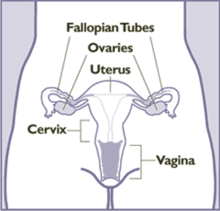This is an old revision of this page, as edited by 66.56.2.191 (talk) at 20:20, 25 October 2005. The present address (URL) is a permanent link to this revision, which may differ significantly from the current revision.
Revision as of 20:20, 25 October 2005 by 66.56.2.191 (talk)(diff) ← Previous revision | Latest revision (diff) | Newer revision → (diff) For other uses, see Vagina (disambiguation).]

The vagina (from the Latin for "sheath" or "scabbard" ) is the tubular tract leading from the uterus to the exterior of the body in female placental mammals and marsupials, or to the cloaca in female birds, monotremes, and some reptiles. Female insects and other invertebrates also have a vagina, which is the terminal part of the oviduct.
Human vagina
The human vagina is an elastic muscular tube about 4 inches (100 mm) long and 1 inch (25 mm) in diameter that connects the vulva at the outside to the cervix of the uterus at the inside. If the woman stands upright, the vaginal tube points in an upward-backward direction and forms an angle of slightly more than 45 degrees with the uterus. The vaginal opening is at the back (caudal) end of the vulva, behind the opening of the urethra. Above the vagina is Mons Veneris.The inside of the vagina is usually pink, as with all internal mucous membranes in mammals.
(In common speech, the term "vagina" is often used improperly to refer to the vulva or female genitals generally; strictly speaking the vagina is a specific internal structure and the vulva is the exterior genitalia only. Calling the vulva the vagina is akin to calling the mouth the throat.)
The vagina has the following functions:
- Admit the penis of the male for sexual intercourse and ultimately the introduction of male gametes (sperm) for the fertilization of ova. Heterosexual post-pubescent males are generally sexually attracted to the human female vagina and the resulting penile erection from such arousal facilitates vaginal penetration. (See: Coitus).
- During live birth, provide the route to deliver the fetus from the uterus to its independent life outside the body of the mother. During birth, the vagina is often referred to as the birth canal.
- Provide a path for menstrual fluids to leave the body.
- Provide sexual pleasure to a woman during the sexual intercourse.
Length, width and shape of the vagina may vary. When a woman gives birth and during sexual intercourse, the vagina widens and lengthens up to 2-3 times.
Vaginal lubrication is provided by glands near the vaginal opening and the cervix and also seeps through the vaginal wall (which does not contain any glands).
The hymen—a membrane situated behind the urethral opening—partially covers the vagina in many organisms, including some human females, from birth until it is ruptured by first coitus, or by any number of other activities including medical examinations, injury, certain types of exercise, introduction of a foreign object, etc.
Some women have a very sensitive erogenous zone called "the G-spot" inside their vagina, which can produce very intense orgasms if stimulated properly. Not all women have a g-spot that is responsive to stimulation, however.
The vagina is examined during gynecological exams, often using an instrument called a speculum, which keeps the vagina open for visual inspection or taking of samples (see pap smear).
See also
- vulva
- vagina dentata
- vulvovaginal disorders
- vagina tightening and toning
- vulvovaginal health
- Skene's glands
- body parts slang
- artificial vagina
- gamete
External links
- The-Clitoris.com
- Pink Parts - "Walk through" of female sexual anatomy by noted sex activist and educator Heather Corinna (illustrations; no explicit photos)
| Female reproductive system | |||||||||||||||||||||||||||||||
|---|---|---|---|---|---|---|---|---|---|---|---|---|---|---|---|---|---|---|---|---|---|---|---|---|---|---|---|---|---|---|---|
| Internal |
| ||||||||||||||||||||||||||||||
| External |
| ||||||||||||||||||||||||||||||
| Blood supply | |||||||||||||||||||||||||||||||
| Other | |||||||||||||||||||||||||||||||